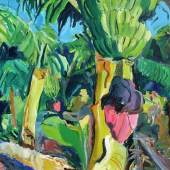Galerie Ernst
Galerie Ernst Hilger at PULSE NEW YORK
-
Messe05.03.2009 - 08.03.2009
Alle Arbeiten von Brian McKee reflektieren den Zusammenbruch moderner Gesellschaften und alter Zivilisationen. Dabei macht der amerikanische Photograph weder in seinen Arbeiten noch in seinen Aufnahmen Hinweise auf ein bestimmtes Land. Brian McKee benützt das lateinische Wort „urbanus" als Überbegriff, denn alle Orte, die er für die URBANUS-Serie photographierte, waren einmal Städte oder verkörperten die Idee einer Stadt. Gleichgültig, welches Projekt oder welches Thema behandelt wird, Brian McKees Bilder sind immer intensive Auseinandersetzungen mit historischen Orten.
All works by Brian McKee reflect the collapse of modern societies and civilizations. In doing so, the American photographer refers to a specific country in his work. He uses the Latin word "urbanus" - meaning urban - as an umbrella concept, since all towns of which he took pictures for the URBANUS project once were towns or represented the idea of a town. Irrespective of the project or subject - Brian McKee's pictures are never documentations but always in-depth analyses of the historic sites.

Daylight Fan (Orbital Camera (Tageslichtventilator [Umlaufkamera]) ist eine neue, kleinformatige virtuelle Skulptur, die der Künstler John Gerrard geschaffen hat. Dieses Werk unterscheidet sich von den jüngsten Arbeiten John Gerrards, da hier die Möglichkeit der Manipulation und des Betrachtens einer virtuellen Szene fehlt. Bei diesem Werk muss man die Zeit verstreichen lassen, um den Gegenstand des Werkes im vollen Umlauf zusehen - in diesem Fall handelt es sich um einen silbernen Ventilator, der so programmiert wurde, dass er nur während der Tagelichtstunden in Betrieb ist. Die Kamera befindet sich im Ventilator und dreht sich mit Erddrehgeschwindigkeit langsam im Objekt. Sie braucht 24 Stunden, um einen vollen Umlauf zu beenden. Man sieht den Ventilator zu Mittag in Frontalansicht, und dann beginnt eine langsame Drehung um 360°, die einen vollen Tag und eine Nacht dauert. Die Arbeit befindet sich in einer virtuellen Darstellung eines Raums im berühmten Wittgensteinhaus in Wien. Sie bleibt im Lichtkreis eines vollen Jahrs mit 365 Tagen, so wie dies auch bei früheren Arbeiten der Fall war. Das Werk hat eine eigenartige, meditative Qualität und erinnert an die Werke des Künstlers mit den Ölförderpumpen. Hinter seiner Schlichtheit verbirgt das Werk die komplexe Interaktion von Kraft, Energie, Wechsel und Nachhaltigkeit. „Daylight Fan (Orbital Camera)" hat eine Auflage von 12 Stück. Sie dient der Unterstützung von John Gerrard / Animated Scene, einem großen gemeinsamen Projekt für die 53. Biennale in Venedig 2009 von John Gerrard / RHA Projects, Dublin.
Daylight Fan (Orbital Camera) is a new, small-scale virtual sculpture created by artist John Gerrard. This piece presents a break with John Gerrard's recent works in that the ability to manipulate and look around a virtual scene is absent. In this work one must wait in time to orbit the subject of the piece - in this case a silver fan, programmed to run only during the hours of daylight. Using the speed of the turn of the earth as guide, a camera in the piece slowly scrolls around the fan, taking 24 hours to complete a full orbit. Thus one sees the fan face on at midday and then one begins a slow 360° turn over the next full day and night. The work, which is sited in a virtual representation of a room from the famous Wittgenstein house in Vienna remains in the light orbit of a 365 day year as in previous works. The piece has a curious meditative quality, reminiscent of the artists recent oil pump works. Its simplicity masks a complex mediation on power, energy, exchange and sustainability. Daylight Fan (Orbital Camera) is presented in an edition of 12 in support of John Gerrard / Animated Scene a major Collateral Project of the 53rd Venice Bienniale 2009 by John Gerrard / RHA Projects, Dublin.

Eines der Schlüsselmotive/-objekte, welches beständig in den Werken von Sara Rahbar wiederkehrt und den Hauptteil ihrer Arbeiten bildet, ist ein Objekt, das bereits seit 4.000 Jahren besteht. Die Fahne, eine der ältesten bekannten Zeichen für Nationalismus und Zugehörigkeit, wird unter ihren kreativen Händen zur Basis ihrer gewebten Bilder. Auf dieser Grundlage platziert sie Symbole, welche sie beim Stöbern durch die Reste des Exodus findet, wo feine Stoffe und Stickereien letztendlich enden - auf Flohmärkten und in abgelegenen Zubehörlagern.
One of the key images/objects that is repetitively used by Sara Rahbar and which forms "the main" body of her work has been an object that has been around for the last 4.000 years. The flag, one of the oldest recognizable symbols of nationalism and belonging, in her spirited hands becomes a foundation for woven paintings, a base upon which to place the accumulated denotations that she rummages through; remnants of the exodus, where ultimately refined textiles and embroideries end up - the flea markets and remote accessory depositories. Text: Shaheen Merali

-
21.01.2025 - 06.03.2025Das Jahr 2025 startet bei der renommierten Galerie Hilger mit einer besonderen Ausstellung des...
-
05.03.2009 - 08.03.2009Messe »









